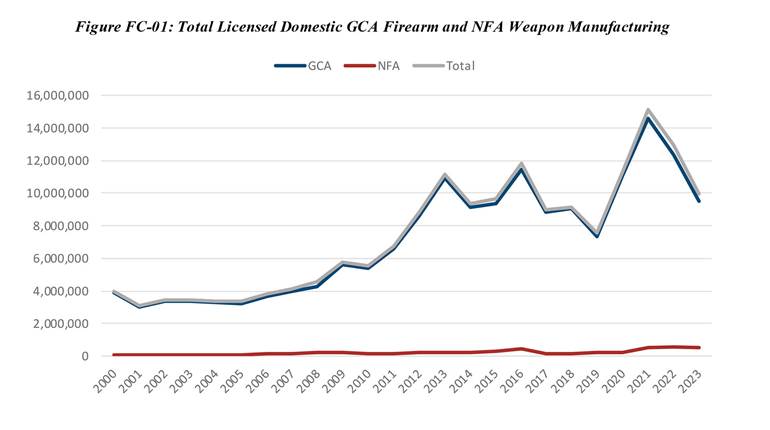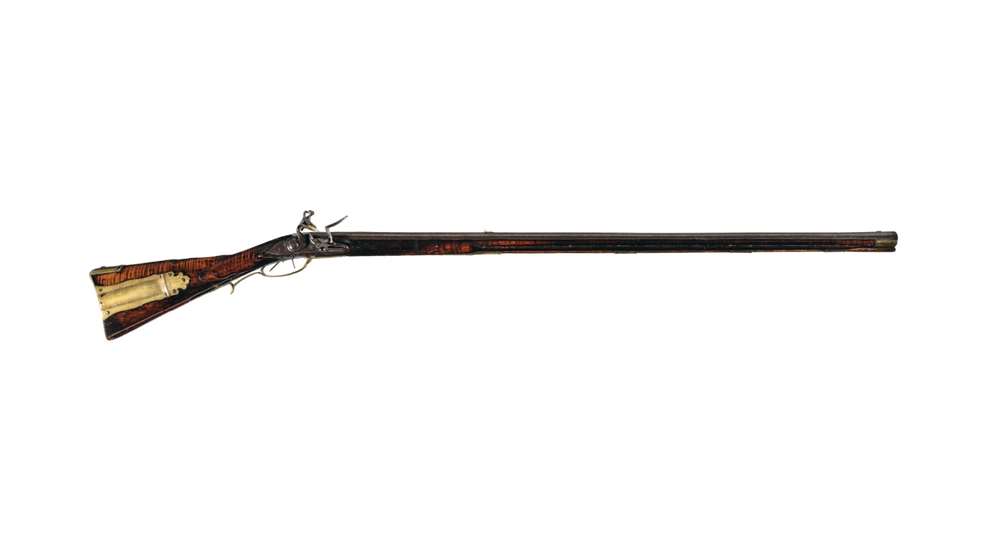
At 13 years of age, a young Daniel Boone was hunting with his short-barreled smoothbore musket harvesting opossums and raccoons. As he grew into a young man, he traded up to his first longrifle. Might it have been made by one of the Lancaster County gunsmiths? With his newly acquired longarm, with its rifled barrel that was accurate at more than 200 yards, Daniel began winning shooting competitions versus men double his age.
The rifled barrel held distinct advantages over the smoothbore. This was first realized by gunsmiths in central Europe in the late 15th and early 16th centuries. A gun barrel scored with spiraling ridges and grooves produced a spinning motion that allows the bullet to fly from the barrel truer, and with greater speed, than that propelled from a smoothbore.
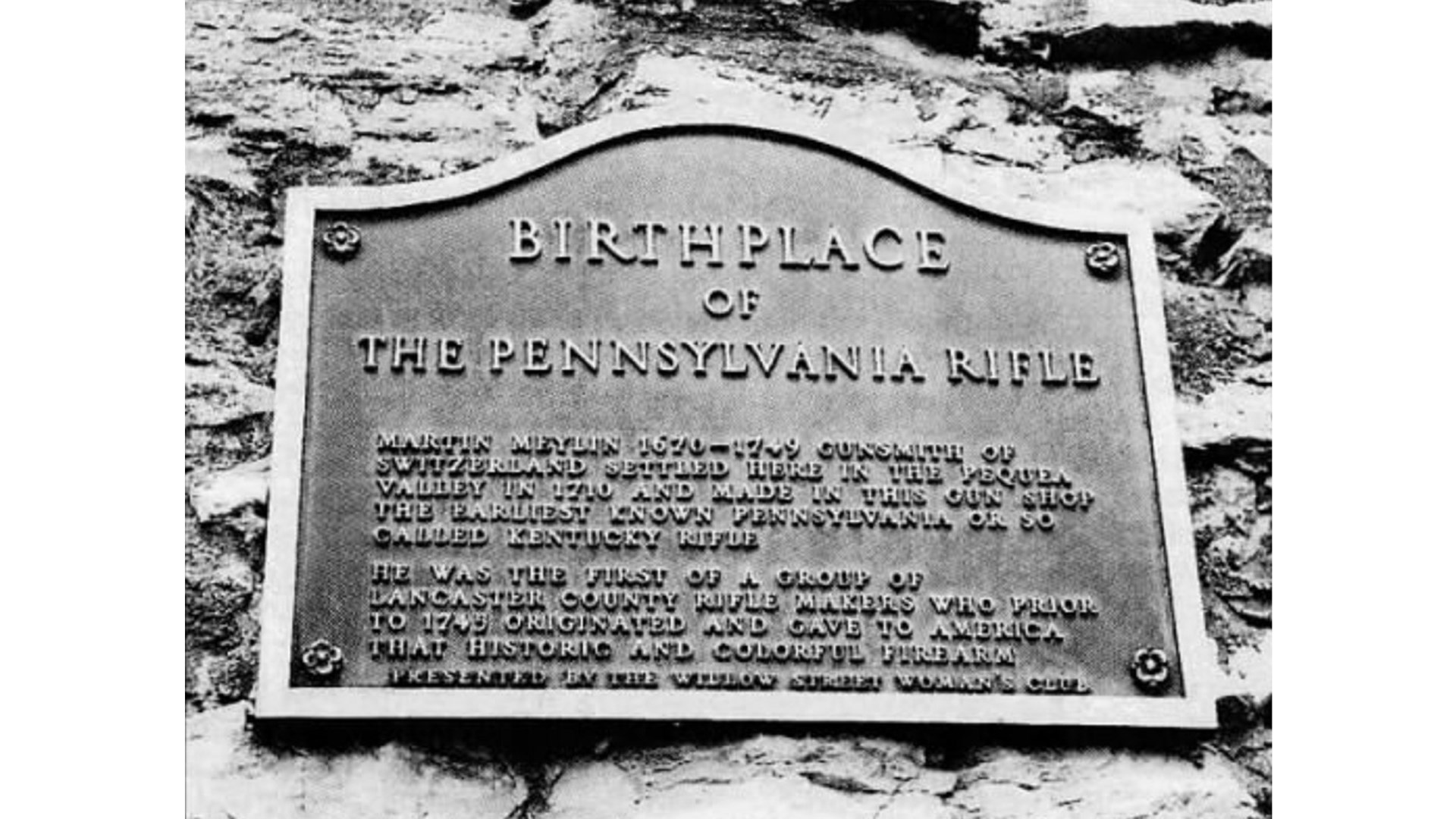 Photo of historic marker denoting the birthplace of the Pennsylvania Rifle—Lancaster County. Courtesy of Intelligencer Journal/Lancaster New Era Lancaster; newspapers.com.
Photo of historic marker denoting the birthplace of the Pennsylvania Rifle—Lancaster County. Courtesy of Intelligencer Journal/Lancaster New Era Lancaster; newspapers.com.
A number of early gunsmiths immigrated from Switzerland to the Lancaster region, bringing their superior ways of gunmaking. Other makers from Germany would soon follow. Before their arrival on Pennsylvania soil, ordnance available was limited to smoothbore muskets and fowling guns. It was these Swiss gunsmiths who introduced the rifled barrel to America.
In 1719, gunsmith Martin Meylin opened his mill, along Piquea Creek to bore rifle barrels; the first endeavor of its kind in Lancaster County—Meylin harnessed the water from the creek to run his operation located at the Eshelman Mill Site. It appears that Martin Meylin is responsible for forging the earliest prototype of the Pennsylvania longrifle. Within two years, Peter Leman began turning out rifles three or four miles east of Lancaster.
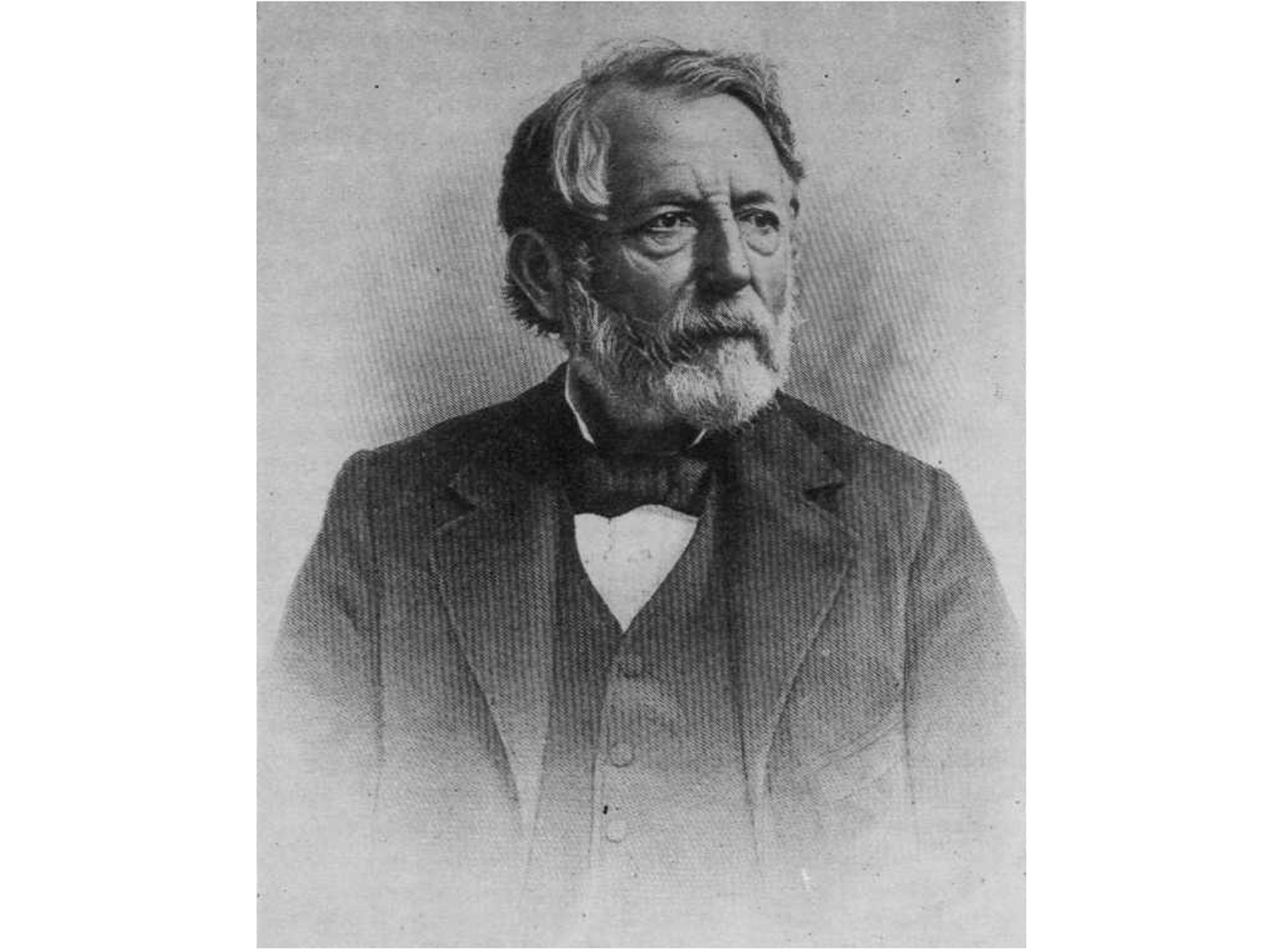 Portrait of Henry E. Leman in later life.
Portrait of Henry E. Leman in later life.
Aside from the aforementioned Meylin and Leman, several other gunsmiths would open up shop in the region, leaving Lancaster County the center of American firearm manufacturing for decades. Matthew Roesser began turning out guns sometime prior to 1744. Most noted William Henry, who may have apprenticed under Roesser, produced rifles as the armorer during General Braddock's disastrous foray against the enemy during the French and Indian War. Henry ran a busy gun shop with several employees. During the American Revolution, Henry played a vital role. So significant was he, that he and his employees were exempt from serving in the Continental Army by the Supreme Executive Council, but there was a caveat to the exemption: rather than military service, his shop had to continue to manufacture arms for the war effort.
Innumerable other gunmakers plied their trade in Lancaster County. The following is but an abbreviated list: Joel Ferree, Jacob Dickert, Peter Brong, Peter Reigart, Peter Gonter, Christian Isch, Melchoir Fordney, and Philip LeFevre. Gunsmith LeFevre manufactured rifles in Leacock Township, Lancaster County. His gun manufactory was on a parcel granted years earlier by William Penn to his father, Isaac. When the nascent government appealed for more guns, LeFevre increased his output from 40 to 50 pieces per week. This is quite an undertaking, as each rifle was created by hand. Jacob Dickert, a master gunsmith, emigrated to America around 1750 and produced rifles with a barrel about 60" in length and weighing around 9 lbs. As with many Lancaster gunsmiths, Peter Gonter secured government contracts to supply guns.
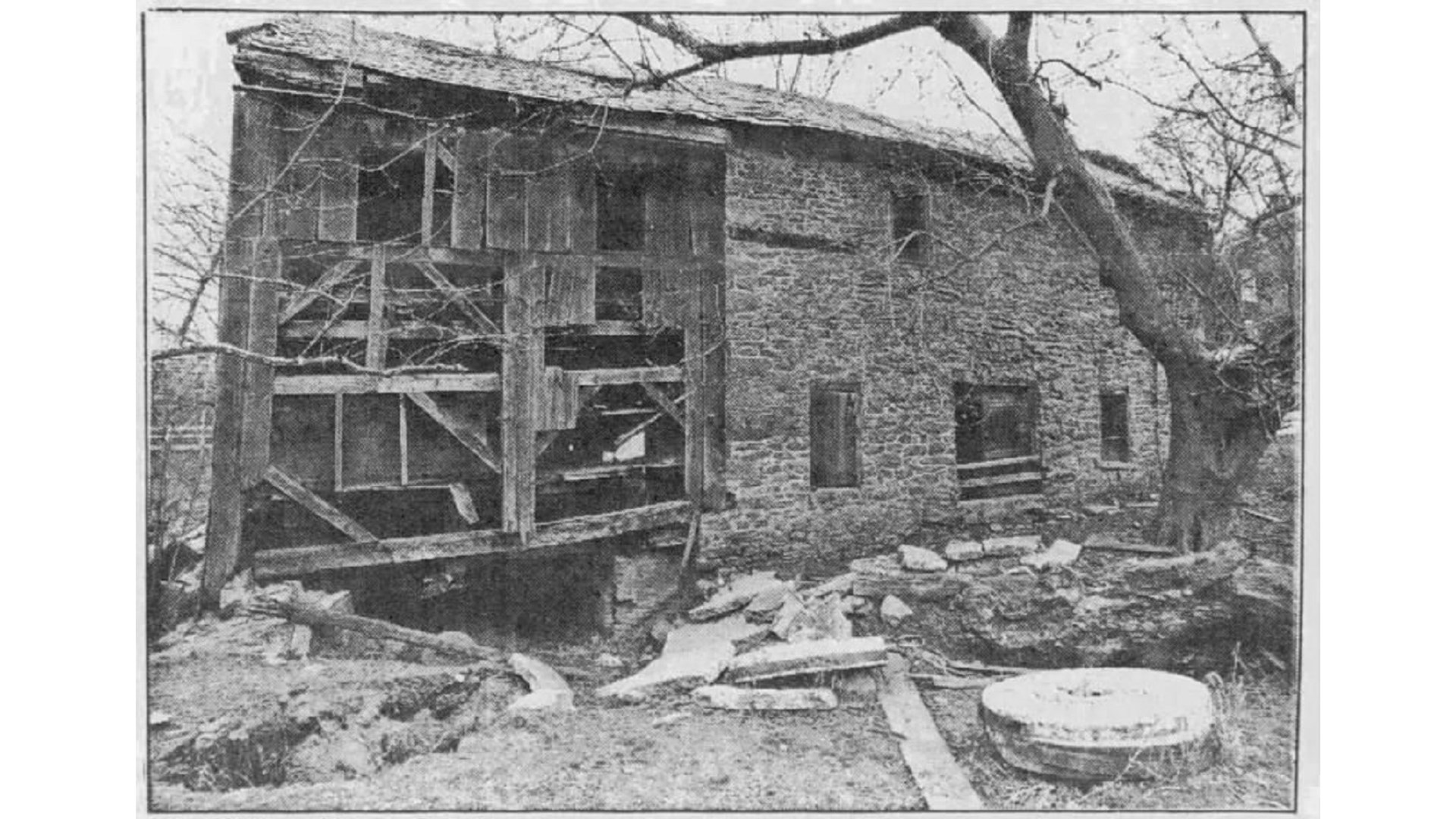 The William Henry Gun Factory. Courtesy of Lancaster New Era; newspapers.com.
The William Henry Gun Factory. Courtesy of Lancaster New Era; newspapers.com.
Rifles weren’t the only product turned out; entire stands that included muskets, bayonets, steel rammers and firelocks were produced. Lancaster gunsmiths sometimes were averse to manufacturing muskets and bayonets for the Continental Army on the terms dictated by the Committee for Safety, which translates into too little money per piece for their labors. To counter this in 1775, the gun manufactories were offered the option of completing arms contracts or suffer the consequences: confiscation of their tools or prohibition of their trade until they completed the arms. Lancaster gunsmiths soon toed the line.
This Lancaster County, Penn., rifle was made by Jacob Dickert sometime between 1761 and the outbreak of the Revolutionary War. The best American marksmen could reliably hit targets at over 200 and even 300 yards with these Lancaster rifles. Courtesy of Rock Island Auction Company.
Despite the superiority of the Lancaster rifle, muskets continued to be made in great numbers to arm the Continental soldiers at a lesser cost than the rifle. This was of great importance to a fledgling new government teetering on financial insolvency. Add to this, the muskets required less time to manufacture. In European-style battles, rows of soldiers marched upon each other firing muskets, leaving little need for the more accurate rifle. In these clashes, the bayonet affixed at the end of the musket barrel was commonly used to do the damage. In longer-range skirmishes, riflemen companies were successful at sniping at British troops from afar. This superiority became apparent when the Virginia riflemen proved their mettle at Great Bridge, and when the North Carolina militiamen peppered the British soldiers at Moore’s Creek Bridge. In both cases, the American riflemen fought from quite a distance while behind cover.
 Courtesy of Rock Island Auction Company, this image features a documented Indian Trade rifle made by Henry E. Leman with a full-length stock with a percussion lock.
Courtesy of Rock Island Auction Company, this image features a documented Indian Trade rifle made by Henry E. Leman with a full-length stock with a percussion lock.
Sometime around 1834, Henry E. Leman, a major player in the world of gunmaking, opened his gun manufactory in Lancaster. It seemed as if Henry Leman was the Henry Ford of gunmakers—setting operations somewhat akin to the Ford assembly line. He expanded operations to a number of buildings to handle various stages in gun manufacturing. One shop forged and rifled the barrels, while another handled the finishing work of polishing the metal parts and making the gun stocks; still others handled various other operations.
With the outbreak of the American Civil War in 1861, Secretary of War Simon Cameron offered Leman a contract for 250,000 rifles. Leman rejected the offer. To comply with the contract, Leman would be faced with hefty expenditures in buying new machinery. If the war was of short duration, the contract for 250,000 rifles would most likely be voided. But Leman accepted a contract from the government to rework thousands of flintlock muskets into percussion guns. Leman’s factory hummed along at a steady pace until Leman passed on in 1887.
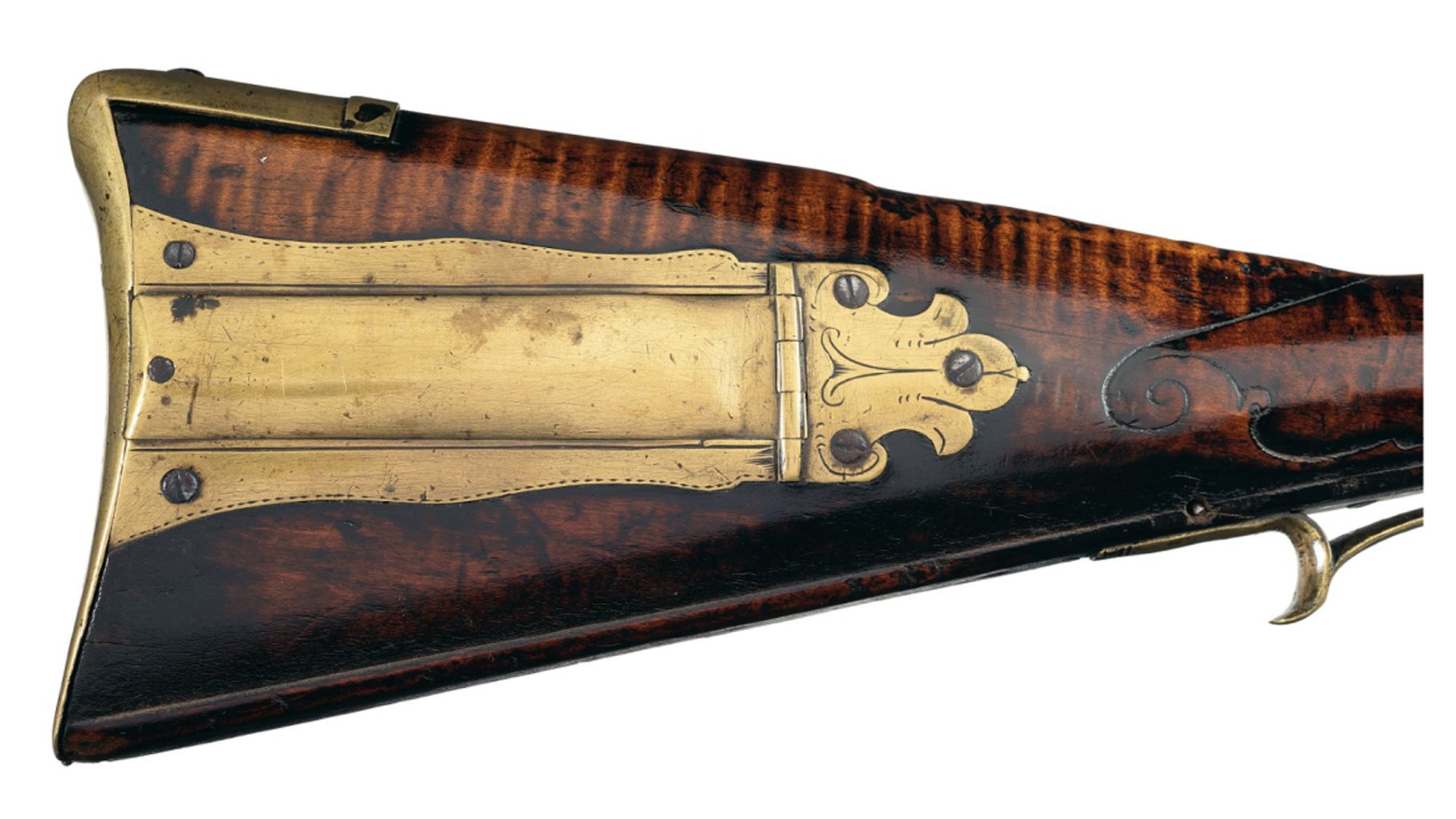 The attractive four-piece patch box of the Jacob Dickert rifle features simple engraving, thin side plates and a plain domed lid. There is a release button for the patch box on the heel behind the buttplate screw. Courtesy of Rock Island Auction Company.
The attractive four-piece patch box of the Jacob Dickert rifle features simple engraving, thin side plates and a plain domed lid. There is a release button for the patch box on the heel behind the buttplate screw. Courtesy of Rock Island Auction Company.
In 1930, Henry Leman’s son, James C. stated most of the workers were German, but it's likely some were of Swiss descent as well. He also stated that this was the last factory of its kind in Lancaster County. It certainly had a long run, as some of the employees started there as youngsters, and remained there until old age put an end to their vocations. Leman’s operations were of large scale, as an 1839 advertisement will attest. It allows that hundreds of rifles are available for sale. In stock shotguns, both the double barrel and single, as well as dueling pistols, are ready for purchase. Another indication of the large production of Leman's gun works is his queries for walnut-gunstock blanks, in large lots up to 2,000 board feet.
 The Kentucky Rifle by Melchior Fordney, shown above, highlights work of the early 19th century during the Golden Age of Pennsylvania long rifles. These guns were not just tools, as they were also intricately beautiful. Courtesy of Pook & Pook Inc.
The Kentucky Rifle by Melchior Fordney, shown above, highlights work of the early 19th century during the Golden Age of Pennsylvania long rifles. These guns were not just tools, as they were also intricately beautiful. Courtesy of Pook & Pook Inc.
As Lancaster was a main point in outfitting expeditions en route to the hinterlands of western Pennsylvania, Ohio and Kentucky, frontiersmen were always coming and going. These men let it be known they preferred a lighter rifle weighing around 10 lbs., with a longer barrel, and with a reduced bore, no more than a .45 or .50 caliber. Lancaster County gunsmiths took heed of these observations—the result was the Lancaster, or Pennsylvania, rifle. It was the perfect tool for hunting in forested areas and when sniping an enemy at a great distance due to its more accurate sights, lighter weight and its frugal requirements for powder and shot. The easier-to-load greased patch-wrapped bullet and hickory ramrod displaced the heavy mallet and iron ramrod of previous longarm designs. Hardwoods of cherry, red maple or walnut were used in producing the gunstocks. As for accouterments added to the piece, to reflect the individuality of the gunsmith a “C” scroll might be carved into the stock. Elaborate metalwork was sometimes requested.
With all the precision that went into crafting Lancaster rifles, they were pricey and government officials made note of that, but still, the military did purchase a number of them. Colonel George Washington in 1758 penned a note to William Henry stating, “as soon as you have complete[d] Ed Byrd’s regiment and Capt. Stuart’s troops of Light Horse, with arms [rifles], you are to set about cleaning and putting all the Virginia arms in the best repairs you can, till further orders.” In another instance, a record was produced in 1794 and signed by General Edward Hand regarding an order of 1,000 rifles made by Lancaster gunsmiths.
 Featuring a 41", full-octagonal, .45-cal. smoothbore barrel, the above 1830 Lancaster County Pennsylvania Percussion Full Stock Rifle, despite its dark patina and slight pitting, is fine example of craftsmanship of the era. The barrel is also signed, with the script initials "A. R." and has a V-notch rear sight and brass blade front sight, both dovetailed in place. Courtesy of Heritage Auctions.
Featuring a 41", full-octagonal, .45-cal. smoothbore barrel, the above 1830 Lancaster County Pennsylvania Percussion Full Stock Rifle, despite its dark patina and slight pitting, is fine example of craftsmanship of the era. The barrel is also signed, with the script initials "A. R." and has a V-notch rear sight and brass blade front sight, both dovetailed in place. Courtesy of Heritage Auctions.
As of 1814 in the town of Lancaster alone, the total number of gunsmiths and gun locksmiths combined reached 24. In the 30-year period from 1810 to 1840, the annual output of stands ballooned from 1,000 to more than 4,500. Several factors fueled the increase in gun sales. After The War of 1812, citizens felt the need to be armed, and as the nation moved westward, so did the U.S. Army, thus causing a demand for more rifles.
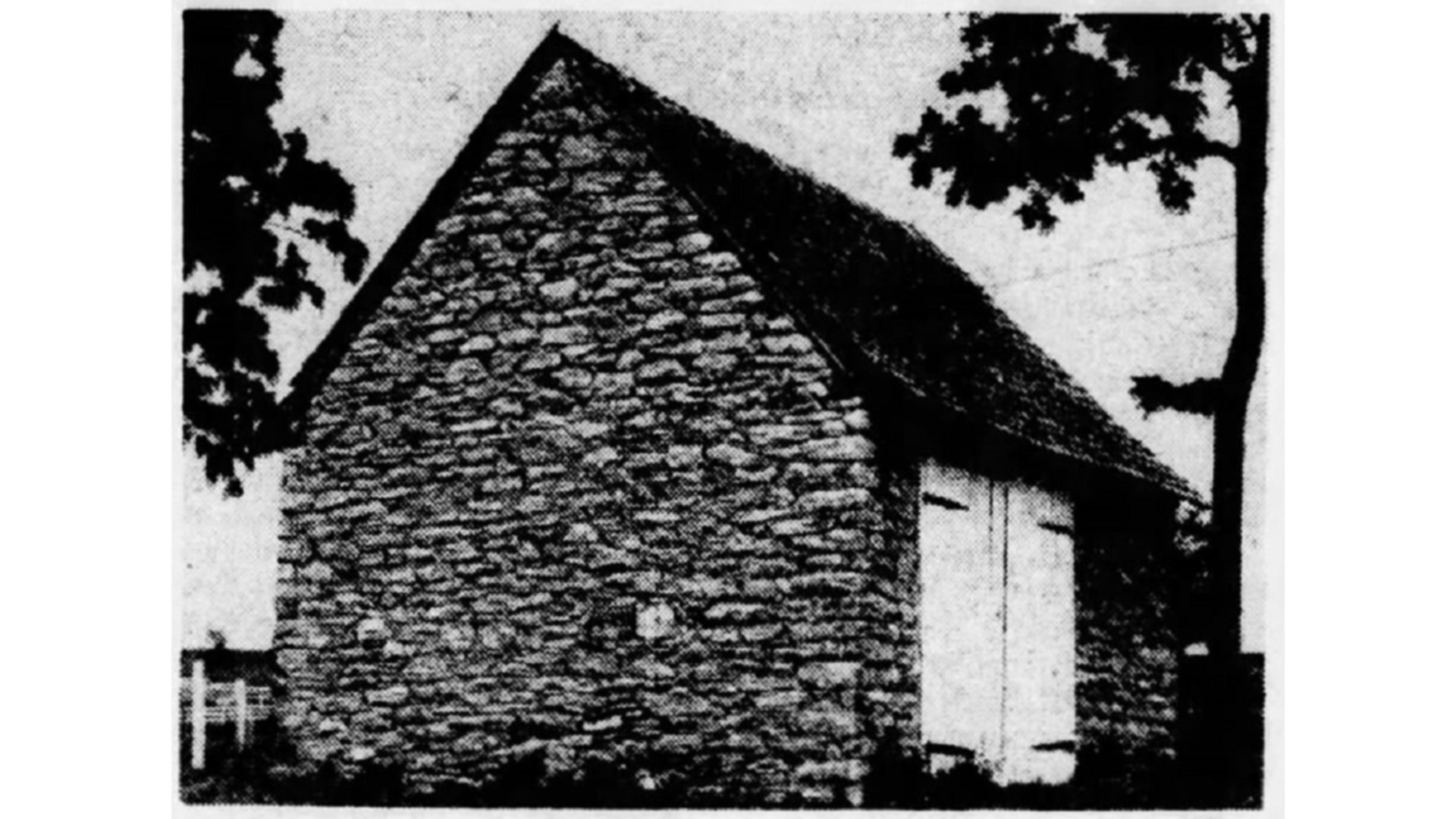 The Pennsylvania Rifle, sometimes also called the Kentucky Rifle, was developed in Lancaster by Swiss gunsmith, Martin Meylin. Built in 1719, the little stone building (above) in Lancaster is the location where the Swiss gunsmith, Martin Meylin developed the Pennsylvania Rifle. Meylin put spiraled grooves in the barrel, known as "rifling." This enhanced barrel made the gun extremely accurate up to 300 yards, which was especially useful as the long rifle was an important tool for American frontiersmen in the 17th and early 18th centuries. The rifle put food on the table, protected homes, and helped win battles in the Revolutionary War and the War of 1812. Courtesy of Intelligencer Journal; newspapers.com.
The Pennsylvania Rifle, sometimes also called the Kentucky Rifle, was developed in Lancaster by Swiss gunsmith, Martin Meylin. Built in 1719, the little stone building (above) in Lancaster is the location where the Swiss gunsmith, Martin Meylin developed the Pennsylvania Rifle. Meylin put spiraled grooves in the barrel, known as "rifling." This enhanced barrel made the gun extremely accurate up to 300 yards, which was especially useful as the long rifle was an important tool for American frontiersmen in the 17th and early 18th centuries. The rifle put food on the table, protected homes, and helped win battles in the Revolutionary War and the War of 1812. Courtesy of Intelligencer Journal; newspapers.com.
Lancaster County was the center of longrifle manufacturing for several decades and as such, offered employment for a great number of workers which, in turn, helped grow the region. No real assemblage of early American firearms is complete without Lancaster-made rifles. The famous Kentucky Rifle was actually manufactured in Lancaster County but was so named for the location where the weapon found its widest use—the Kentucky region. What is especially ironic is that the land on which numerous gunsmiths created killing instruments was granted to them by the peace-loving Quaker William Penn.













